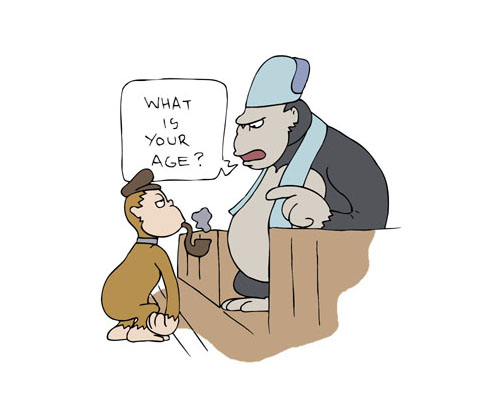Remembering Gender when learning Foreign Languages
Be careful - don't call your Dad a marvellous woman!
Remembering the Gender of a noun is one of the trickiest things when learning many a foreign language...
... and if you are not careful you could end up calling your Dad a marvellous woman... but . . . there is help at hand!
Read on...
Just what is a Gender in a foreign language?
The gender of a noun is its 'sex'.
In English we have no genders, but in many languages nouns have different genders or 'sex'.
They are either male or female - masculine or feminine!
… and sometimes other things as well.
To recap some basic grammar, a noun is a word that describes a THING.
In French there are two genders - Masculine and Feminine.
In Spanish there are two genders - Masculine and Feminine.
In German there are three genders - Masculine, Feminine and Neuter.
In Welsh there are two genders - Masculine and Feminine.
In Italian there are two genders - Masculine and Feminine.
Why Learn the Gender of a Word?
It is important for you to know the gender of a noun when learning a foreign language, because:
- it is a vital part of the word, and always included with the word itself, and
- the adjectives that describe the noun, change with the gender.
The two must match.
If the noun and adjective do not you may end up describing a 'masculine' object with a feminine adjective.
It is like calling a 'him' a 'her' in English, or a 'her' a 'him'.
While people will generally know what you mean, it is not right.
So you must know the gender of the noun when using it.
For example in Spanish . . . .
...my father is mi padre.
...my marvellous father is mi padre maravilloso.
...my mother is mi madre.
...my marvellous mother is mi madre maravillosa.
Note the endings of the adjective 'maravilloso' are slightly different for the masculine case (my father) - 'maravilloso' and the feminine case (my mother) - 'maravillosa'
The masculine adjective ends in the letter 'o' and the feminine adjective ends in the letter 'a'.
However if you indavertently said:
mi padre maravillosa you would be describing your dad as a marvellous woman!
Likewise if you inadvertently said:
mi madre maravilloso you would be describing your mother as a marvellous man!
So this illustrates the importance of knowing the genders when learning a foreign language which has genders.
[Of course, one must be prepared to make mistakes in language learning, but nevertheless with the right tools, one can reduce their frequency!]
What is the Best Way to Learn Genders when learning a new language such as French, Spanish, German, Italian, Welsh?
Of course the best way to learn the rules of any language is to learn naturally in a total immersion environment from an early age!
However the early age will have passed by most people reading this website, so how do we best learn the gender of a word.
Well, most courses do not have any particular technique for teaching gender when teaching foreign vocabulary.
Most just teach the word with its 'definite article', and this tells you the gender.
So most courses just give you a long list of words, with their articles.
What is the Definite Article and the Indefinite Article?
The 'definite article' is the word 'the' in English.
The 'indefinite article' is the word 'a' or 'an' in English.
In Spanish the 'definite article' for masculine words is el.
In Spanish the 'definite article' for feminine words is la.
In French the 'definite article' for masculine words is le.
In French the 'definite article' for feminine words is la.
In German the 'definite article' for masculine words is der.
In German the 'definite article' for feminine words is die.
In German the 'definite article' for neuter words is das.
So most courses just list the words, and you just have remember the article, and gender that goes with it.
That takes a lot of time, is laborious and requires a lot of repetition.
99% of language courses use this 'traditional learning' technique.
It is slow, it is tedious, and it causes lots of language students to give up learning!
So to answer the question regarding "What is the most efficient and least-effort way to learn genders when learning a modern foreign language such as Spanish, French, German?", the answer is:
You should learn the gender when you learn the word, and the most effective way to implant this is through the use of a Gender Trigger ©.
Furthermore, the Memory Masters of the world tell us that if you incorporate the word into a funny visualisation, your recall of the word can improve as much as tenfold or more.
The most effective technique for remembering genders in foreign language learning is to have such a 'funny visualisation' or 'word-picture association' and to incorporate that into the initial learning of the word.
To explain that another way it is best to use an example.
Let us take the French word for cat which is chat.
In this case the word sounds like 'SHA' because the letter 't' at the end of the word is silent.
Cat in French, chat, is a masculine word… so it is: le chat.
Now traditional teaching techniques would teach you this by telling you the word is le chat, and you would have to remember this, doing so by repeating the word again and again and again, (and again etc)
Trouble is, that when it comes time to use it, one often forgets the gender!
However if you had learnt the word WITH a gender trigger your brain would have a MEMORY HOOK, a way of remembering the gender, a GENDER TRIGGER that will spark your recall.
If you had learnt the word with a word-picture assocation cartoon, the picture would be planted into your subconscious.
To do this our technique is to give you the GENDER TRIGGER with the initial teaching of the word.
So for the word le chat in French, it sounds like le SHAH.
So we give you the picture of the SHAH of Iran with a cat on his lap.
The SHAH is a famous person, the former King of Iran, and the word SHAH reminds you of the French word chat (which sounds like SHAH), and because he is masculine, it reminds you that the word is a masculine word.

This Word Association Picture shows the SHAH of Iran, Shah Reza Pahlavi, with a cat on his lap, reminding you of the French word for cat, which is chat, (pronounced SHAH) and reminding that the gender of the word is masculine, because the main character, the Shah, is a male.
© Exceltra 2006
It doesn't just stop there.
We add further GENDER TRIGGERS and hooks as well.
Gender Trigger #2
The voice that announces the word in English on the CD-Rom program is male for masculine words, and female for feminine words.
Gender Trigger #3
The voice that announces the word in the foreign language (e.g. French, Spanish, German, Welsh etc) on the CD-Rom program is male for masculine words, and female for feminine words.
Gender Trigger #4
The text in our courses is COLOR CODED:
blue for masculine words
red for feminine words.
So when you embark on your vocab learning in your foreign language learning strategy do be sure to check if your program does all of the above.
Actually I can save you the hassle of checking and can tell you now that out of the thousands of language courses on the market the 200 Words a Day! system is the only one that does this!
But if you do find one that does, please do let us know.
Rules of Thumb in Remembering Genders in Foreign Language Learning Spanish
As a general rule in Spanish most nouns and adjectives ending in the letter 'o' are masculine…. and ….
most nouns and adjectives ending in the letter 'a' are feminine…. but ….
…of course there are many exceptions…
so if you have learned words with a word-picture association cartoon with an 'inbuilt' gender trigger you will have the tools to know the many exceptions to the rules!
How to Remember the Gender of German Words - Masculine, Feminine and Neuter nouns
As if learning masculine and feminine genders is not enough, learning the German language is made a little more difficult still, by the addition of a third gender for German nouns - the neuter gender.
In German the 'definite article (the)' for masculine or male words is der.
In German the 'definite article' for feminine or female words is die.
In German the 'definite article' for neuter words is das.
The biggest difficulty with these German language genders is that there is no real 'rhyme nor reason' as to whether a word is masculine, feminine or neuter.
For example the word for a little girl is das Mädchen, which is a NEUTER word.
If one was to guess, most would think it was a feminine word!
So you can see how a Gender Trigger will enhance your ability to recall words and gender.
To remember Neuter Words in German we give you the most powerful Gender Trigger possible.
If you learn the word WITH a gender trigger your brain would have a MEMORY HOOK, a way of remembering the gender, a GENDER TRIGGER that will spark your recall.
If you learn the word with a word-picture assocation cartoon, the picture would be planted into your subconscious.
To do this, our technique is to give you the GENDER TRIGGER with the initial teaching of the word.
So just as we do for the French and Spanish courses we put a male main character as a means of you remembering the male gender of a masculine German word.
We give you a picture of a female main character as a means of helping you remember the gender of a feminine German word.
We use loads of different famous people and celebrities in our Memory Triggers which makes these Memory Triggers and Gender Triggers all the more memorable.
In addition to this we have invented the most powerful German gender trigger to teach the German neuter gender for nouns, and this will improve your recall of these nouns.
We invented the technology of the 'smoking animal'.
So with our Memory Triggers for German neuter nouns we add a 'smoking animal' to the scene.
The presence of the smoking animals allows the learner to remember this crazy scene, and its smoking animals remind you of the gender. The word-picture associations remain strongly implanted in your brain, for tremendous recall!
Here's an example...
The word for age in German is das Alter. So we imagine a young monkey smoking at the ALTER being asked his age. . .

The smoking animal in German gender recognition is simply an awesome tool... because there are so many different animals giving a wide selection of 'silly scenes' by which to remember words and phrases.
But, in addition to the smoking animal © technology there is more...
We add further GENDER TRIGGERS and memory hooks to each and every German noun in the course.
German Gender Trigger #2
The voice that announces the English word on the 'Learn German 200 Words a Day!' CD-Rom program for masculine words is a male voice, and a female voice for feminine German words.
German Gender Trigger #3
The voice that announces the word to the learner in German on the 200 Words a Day Learn German CD-Rom programme is a male voice for masculine words, and a female voice for feminine words.
For neuter words we add an 'echo' sound to differentiate between those of the other genders.
These various auditory effects add a further aspect to auditory sense when learning the German words are being learnt. You tend to remember the intonation, and sound of the word - further subtly enhancing recall.
German Gender Trigger & Recognition Tool #4
The text in our courses is COLOR CODED:
blue for masculine German words
red for feminine German words.
orange for neuter German words.
Using Famous People to assist your Recall and Gender Recognition
Because we all remember famous people and celebrities better than 'ordinary folk', we include loads of celebrities with our Memory Triggers and Gender Triggers.
Look out for such names as:
Micheal Jordon
George Bush
Micahel Jackson
Cher
President Reagan
Abraham Lincoln
Benjamin Franklin
...and hundreds more!
So when you embark on your vocab learning in your foreign language learning strategy do be sure to check if your program does all of the above.
Actually I can save you the hassle of checking and can tell you now that out of the thousands of language courses on the market the 200 Words a Day! system is the only one that does this!
To find out more about the 200 Words a Day! Excelerated Language Learning Courses check out the links.
WELSH Course #1 - 1000+ words & common phrases. Gender Triggers for all Welsh nouns.
What is the Best Way of Learning Genders when Learning Foreign Languages
200 Words a Day! and Exceltra
©Copyright
2004-2023 All Rights Reserved
IMAGINE how you'd
FEEL
seeing yourself learning at a rate of 200 words a day ... the ideal companion course that complements any language course.
|










New! Comments
Have your say about what you just read! Leave us a comment in the box below.